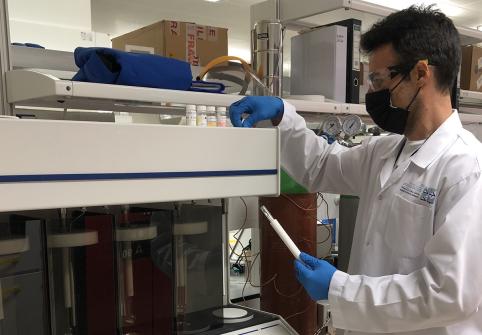News
Research and Development Efforts by Qatar Environment and Energy Research Institute Focus on Innovation in Carbon Capture, Utilization, and Storage Technologies
08 Jun 2021QEERI’s CCUS Project aims to reduce carbon footprint of industrial operations

The Energy Center at Qatar Environment and Energy Research Institute (QEERI), part of Hamad Bin Khalifa University (HBKU), is sharpening its focus on research, development, and innovation in carbon capture and utilization technologies. These initiatives form part of the Institute’s commitment to delivering solutions that reduce the carbon footprint of industrial operations by developing processes and technologies able to convert carbon dioxide (CO2) into value-added products. This in turn contributes to monetizing industrial waste and diversifying the economy in line with Qatar National Vision 2030.
Fifty-one billion tons (51 Gt) of greenhouse gases are currently emitted into the atmosphere every year, which has been demonstrated to have a direct impact on current undesirable climate change patterns. Of this, about 37 Gt is CO2, highlighting an increasing trend year on year. With a growing global population and continuous use of relatively low cost of fossil fuel per energy unit it is anticipated that it may result in a 50-100% increase in CO2 concentration by 2030 in a business-as-usual scenario. Zero net carbon emissions are not easily achievable within a short time span and even a 100% move to renewable sources of energy may not result in a significant dent in the CO2 atmospheric concentration levels. Sustainable industrial and societal development can only be achieved through collective efforts in adapting commercially viable and renewable technologies, along with the enhanced and optimized use of natural gas, CO2-derived feedstock (carbon utilization), and existing atmospheric CO2 (carbon capture).
In this context, R&D efforts that focus on the industrial utilization of CO2 for value-added materials and commodities are key due to its abundant, cheap, and non-toxic nature. At present, less than 1% of net anthropogenic release of CO2 is utilized by industry, making it a potentially competing and underutilized feedstock for the chemical industry which could create huge economic opportunities while providing solutions to mitigate the effects of climate change.
QEERI’s Energy Center mandate is to support the competitiveness and sustainability of Qatar’s energy sector through the development and deployment of technological solutions. These include improving the environmental impact of natural gas, developing and improving carbon capture technologies, and innovation in the uses of CO2 through new technologies to make it more attractive in the long term.
QEERI’s Carbon Capture, Utilization, and Storage (CCUS) project is developing processes and technologies able to convert CO2 into value-added products aimed at reducing the carbon footprint. The research activities are focused on CO2 mineralization to produce carbonate products; CO2 electroreduction to electrochemically convert CO2 into less polluting and more valuable chemicals; and CO2 absorption to find more sustainable yet efficient scrubbing systems. The CO2 mineralization project has the potential for tackling three main issues of global and national relevance: CO2 emissions, brine, and alkaline waste.
Dr. Veronica Bermudez, Senior Research Director, Energy Center, said: “At QEERI, we are proud to have teams of highly skilled and experienced scientists, researchers, and engineers, supported by a world-class facility which includes the Applied Chemistry Laboratory, the Chemical Synthesis Laboratory, and the Electrochemistry Laboratory. At these facilities, we can conduct all the required experiments right from preparation and characterization of materials and nanoparticles, the synthesis of organometallic systems to prepare new generations of heterogeneous or homogeneous catalysts, preparation and testing of electrochemical cells, the testing of novel electrode and membrane materials for CO2 and other gases electrochemical conversion. This intense experimental work needs support from equally intense modelling and computational efforts in order to shorten the development path of potential technology solutions and products; QEERI also has a high-performance computer, a Cray XC-50 machine with 120 compute nodes totaling 4800 cores and 1 PB of storage capacity, designed for heavy computation, especially those calling for atomistic simulation at classical and quantum mechanical level of physicochemical processes especially of interest for the Catalysis and Processes Team.”
By combining experimental efforts and computational modeling through mechanistic understanding, QEERI aims to accelerate the discovery of new catalysts and small molecules, as well as revealing reaction pathways that are relevant to the CCUS project.
Dr. Marc Vermeersch, Executive Director of QEERI, added: “Due to its activities in the main industry sectors (oil and gas, metal manufacturers, and the petrochemical industry), Qatar has been ranked in the top three for per capita CO2 emissions. For a country in constant growth, and targeting to become carbon neutral, it is now crucial to start investing in technologies and policies to reduce CO2 emissions or to transform CO2 into value-added products. Our research will contribute towards tackling the environmental issues related with CO2 footprint in Qatar and globally. It will also enhance Qatar’s standing as a country that values sustainability, and quality of life.”
Sustainability is a key driver influencing the research that QEERI undertakes through its work at the Energy Center, and various other centers and departments, and underscores QEERI’s commitment to helping Qatar tackle its grand challenges related to energy, water, and environment.
